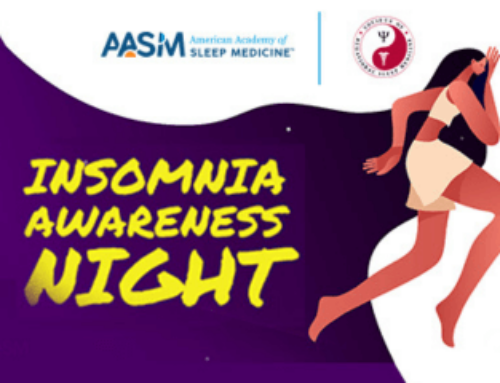FOR IMMEDIATE RELEASE
CONTACT: Lynn Celmer, lcelmer@aasm.org, 630-737-9700
DARIEN, IL – New research suggests that insomnia is a major contributor to deaths caused by motor vehicle crashes and other unintentional fatal injuries. The results underscore the importance of the “Sleep Well, Be Well” campaign of the National Healthy Sleep Awareness Project.
Results show that the risk of unintentional fatal injury increased in a dose-dependent manner with the number of insomnia symptoms present. People with all three symptoms of insomnia were 2.8 times more likely to die from a fatal injury than those with no insomnia symptoms, even after adjusting for potential confounders such as alcohol consumption and daily use of sleep medication.
Among the three insomnia symptoms, difficulty falling asleep appeared to have the strongest and most robust association with fatal injuries. People who almost always had difficulty falling asleep were more than two times more likely to die from a motor vehicle injury (hazard ratio = 2.40) and more than 1.5 times more likely to die from any fatal injury (HR = 1.66) than people who never had trouble initiating sleep. Further analysis found that self-reported difficulty falling asleep contributed to 34 percent of motor vehicle deaths and eight percent of all unintentional fatal injuries, which could have been prevented in the absence of insomnia.
“Our results suggest that a large proportion of unintentional fatal injuries and fatal motor vehicle injuries could have been prevented in the absence of insomnia,” said lead author Lars Laugsand, MD, PhD, postdoctoral fellow in the department of public health at the Norwegian University of Science in Technology in Trondheim, Norway. “Increasing public health awareness about insomnia and identifying and treating people with insomnia may be important in preventing unintentional fatal injuries.”
The study results are published in the November issue of the journal Sleep.
“Healthy sleep is essential for physical health, mental well-being, and personal and public safety,” said American Academy of Sleep Medicine President Dr. Timothy Morgenthaler, a national spokesperson for the Healthy Sleep Project. “Sleep is a necessity, not a luxury, and the promotion of healthy sleep should be a fundamental public health priority.”
Earlier this year the Healthy Sleep Project launched the “Sleep Well, Be Well” campaign to increase awareness of the importance of sleep as one of the three pillars of a healthy lifestyle. More details are available at www.projecthealthysleep.org.
The study involved the analysis of population-based survey data from 54,399 men and women between 20 and 89 years of age. Cause of death was identified using a national registry. During the 13-year follow-up period there were 277 unintentional fatal injuries, including 169 deaths from falls and 57 deaths from motor vehicle crashes.
According to the Centers for Disease Control and Prevention, there are more than 126,000 unintentional injury deaths in the U.S. each year, making it the fifth leading cause of death. There are more than 33,000 motor vehicle traffic fatalities and more than 27,000 unintentional fall deaths annually, as well as 29.3 million emergency department visits related to unintentional injuries.
The study was supported by the Norwegian University of Science and Technology, the Central Norway Regional Health Authority, the Swedish Council of Working Life and Social Research, and the Swedish Research Council.
To request a copy of the study, “Insomnia Symptoms and Risk for Unintentional Fatal Injuries – The HUNT Study,” or to arrange an interview with the study author or an AASM spokesperson, please contact Communications Coordinator Lynn Celmer at 630-737-9700, ext. 9364, or lcelmer@aasm.org.
The monthly, peer-reviewed, scientific journal Sleep is published online by the Associated Professional Sleep Societies LLC, a joint venture of the American Academy of Sleep Medicine and the Sleep Research Society. The AASM is a professional membership society that improves sleep health and promotes high quality patient centered care through advocacy, education, strategic research, and practice standards (www.aasm.org).
About the National Healthy Sleep Awareness Project
The Healthy Sleep Project addresses the sleep health focus area of Healthy People 2020, which provides science-based, 10-year national objectives for improving the health of all Americans. The sleep health objectives are to increase the medical evaluation of people with symptoms of obstructive sleep apnea, reduce vehicular crashes due to drowsy driving and ensure more Americans get sufficient sleep. For more information, visit
www.sleepeducation.org/healthysleep.




